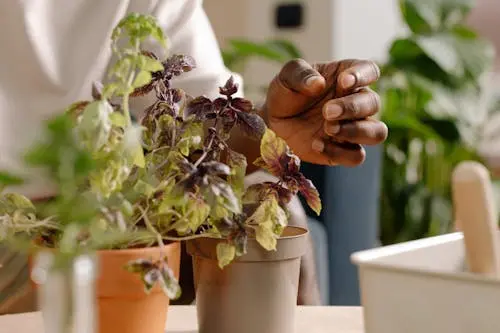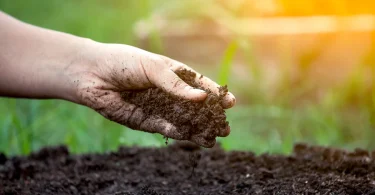Basil (Ocimum basilicum), with its aromatic leaves and culinary versatility, is a must-have herb for any kitchen garden. For example, its vibrant flavor enhances dishes from pesto to salads. Propagating basil from cuttings is a simple, cost-effective way to grow lush, productive plants without seeds. Consequently, this method allows you to replicate your favorite varieties and enjoy fresh basil year-round. This guide provides expert tips to successfully grow basil from cuttings, ensuring a thriving, aromatic harvest.
Why Grow Basil from Cuttings?
Basil is prized for its fragrant leaves, ease of growth, and ability to thrive in gardens or indoors. For instance, propagating from cuttings is faster than growing from seeds, often yielding rooted plants in just 1–2 weeks. Moreover, it ensures identical plants to the parent, preserving desired traits like flavor or leaf size. Hardy as an annual in most climates or a perennial in USDA zones 10–11, basil is ideal for both outdoor and indoor gardening. As a result, cuttings make it easy to maintain a steady supply of this culinary staple.
Step-by-Step Guide to Growing Basil from Cuttings
1. Choose Healthy Basil Cuttings
- Quality Matters: Select healthy, non-flowering stems (4–6 inches long) from a vigorous basil plant. For example, look for stems with vibrant green leaves, no pests, and at least 2–3 nodes (where leaves attach).
- Timing: Take cuttings in spring or summer for optimal rooting, as warmer temperatures promote growth. However, indoor propagation works year-round with proper light.
- Tools: Use clean, sharp scissors or pruning shears, sterilized with rubbing alcohol, to prevent disease transmission.
2. Prepare the Cuttings
- Cutting Method: Make a clean, 45-degree cut just below a node to maximize rooting potential. For instance, this increases the surface area for root growth.
- Leaf Removal: Remove the lower leaves, leaving 2–4 leaves at the top to support photosynthesis while reducing moisture loss.
- Callusing (Optional): Let cuttings sit in a shaded, dry area for 1–2 hours to form a callus, which can reduce rot risk. However, basil cuttings often root well without this step.
3. Rooting Basil Cuttings
- Rooting Options:
- Water Rooting:
- Place cuttings in a jar of filtered or distilled water, ensuring nodes are submerged but leaves remain above water.
- Change water every 2–3 days to keep it fresh and prevent bacterial growth.
- Position in bright, indirect light (e.g., near a north- or east-facing window).
- Roots typically form in 7–14 days.
- Soil Rooting:
- Dip the cut end in rooting hormone (optional) to encourage faster rooting.
- Plant cuttings 1–2 inches deep in a well-draining mix (equal parts potting soil, perlite, and sand or peat moss).
- Water lightly to keep soil moist but not soggy, and cover with a clear plastic bag to maintain humidity, leaving a small opening for air circulation.
- Place in bright, indirect light.
- Water Rooting:
- Root Development: Check for roots after 1–2 weeks. For example, gently tug soil-rooted cuttings to feel resistance, indicating root growth.
4. Transplanting Rooted Cuttings
- Timing: Transplant water-rooted cuttings when roots are 1–2 inches long (1–3 weeks) or soil-rooted cuttings when new growth appears (2–4 weeks).
- Potting:
- Use a 4–6 inch pot with drainage holes, filled with a mix of potting soil, compost, and perlite (2:1:1 ratio).
- Plant cuttings at the same depth as in the rooting medium, firming soil gently.
- Water thoroughly and place in bright, indirect light for 1–2 weeks to acclimate.
- Outdoor Planting: In zones 10–11 or after the last frost in cooler zones, transplant to a garden bed, spacing plants 12–18 inches apart for air circulation.
5. Care for Your Basil Plants
- Light: Provide full sun (6–8 hours daily) for lush growth and strong flavor. For instance, indoor plants thrive near south- or west-facing windows or under grow lights.
- Watering: Water when the top inch of soil is dry, typically every 5–7 days in spring/summer. Reduce watering in fall/winter for indoor plants. Consequently, avoid overwatering to prevent root rot.
- Fertilizing: Apply a balanced, water-soluble fertilizer (e.g., 10-10-10) every 4–6 weeks during the growing season. Alternatively, use a nitrogen-rich fertilizer (e.g., 10-5-5) to promote leafy growth. Avoid over-fertilizing to prevent flavor loss.
- Pruning: Pinch back stem tips above a leaf pair every 2–3 weeks to encourage bushiness and prevent flowering, which reduces leaf flavor. For example, regular pruning yields more harvestable leaves.
- Pest and Disease Management: Monitor for aphids, spider mites, or fungal issues like fusarium wilt. Therefore, treat pests with insecticidal soap or neem oil and ensure good air circulation to prevent fungal diseases.
6. Growing Basil in Containers
- Pot Selection: Use a 6–8 inch pot with drainage holes. Terracotta or plastic pots work well for basil’s moderate root system.
- Soil Mix: Combine potting soil, compost, and perlite (2:1:1 ratio) for drainage and fertility.
- Care: Place in full sun, water when the top inch of soil is dry, and fertilize monthly. For instance, containers are ideal for small spaces or indoor kitchens. Move indoors in zones 4–9 before frost.
7. Overwintering and Protection
- Zones 10–11: Mulch around the base with 2–3 inches of straw or bark in late fall to protect roots from light frosts. Prune frost-damaged stems in spring.
- Zones 4–9: Grow as an annual or in containers, bringing indoors before the first frost. Place in a sunny window or under grow lights, reducing watering to every 2–3 weeks.
- Frost Protection: Cover outdoor plants with frost cloth during unexpected cold snaps in marginal zones to extend the growing season.
Common Challenges and Solutions
- Few Leaves or Weak Growth: Insufficient light or nutrient deficiency. Therefore, ensure 6–8 hours of sunlight and fertilize regularly during the growing season.
- Yellowing Leaves: Overwatering or poor drainage. For example, water only when the top inch is dry and use well-draining soil.
- Pests: Aphids or spider mites may appear. Consequently, treat with insecticidal soap or neem oil and improve air circulation.
- Flowering: Early flowering reduces leaf production. Thus, pinch off flower buds promptly to focus energy on foliage.

Tips for Success
- Propagation Ease: Basil cuttings root quickly, making it easy to grow multiple plants from one parent. For instance, a single stem can yield a new plant in weeks.
- Variety Selection: Try popular varieties like Genovese (classic pesto flavor), Thai (spicy, licorice-like taste), or Purple Basil (ornamental and flavorful).
- Culinary Use: Harvest leaves regularly for fresh use or dry for long-term storage. For example, pinch leaves in the morning for peak flavor.
- Zone Considerations: In zones 4–9, treat as an annual or overwinter indoors. In contrast, zones 10–11 support year-round outdoor growth with protection.
- Companion Planting: Pair basil with tomatoes or marigolds to deter pests and enhance garden aesthetics.
Fun Facts About Basil
- Cultural Significance: Basil is considered a symbol of love in some cultures and is used in religious rituals in others.
- Medicinal Uses: Traditionally used for its anti-inflammatory and digestive benefits, basil is more than just a culinary herb.
- Pollinator-Friendly: Basil flowers attract bees and butterflies, boosting garden biodiversity.
Troubleshooting Table
| Issue | Cause | Solution |
|---|---|---|
| Few leaves/weak growth | Low light or nutrient deficiency | Ensure 6–8 hours of sun, fertilize with nitrogen-rich fertilizer. |
| Yellowing leaves | Overwatering or poor drainage | Water when top inch is dry, use well-draining soil. |
| Pests | Aphids or spider mites | Treat with insecticidal soap or neem oil; improve air circulation. |
| Early flowering | Stress or maturity | Pinch off flower buds, maintain consistent care to focus on leaf growth. |
Conclusion
Growing basil from cuttings is a lush, rewarding way to enjoy fresh, aromatic herbs year-round. By selecting healthy cuttings, providing proper care, and addressing challenges promptly, you’ll cultivate thriving basil plants for your kitchen. For example, with minimal effort, you can propagate endless plants from a single stem. Start growing basil from cuttings today, and savor the vibrant flavors of your homegrown harvest!



